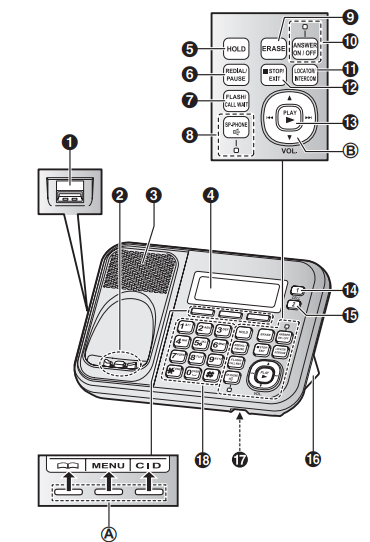
Panasonic KX-TG7875S Link2Cell Bluetooth Cordless Phone
ABOUT Panasonic
Panasonic Corporation is a multinational electronics company headquartered in Osaka, Japan. It was founded in 1918 by Konosuke Matsushita and originally started as a vendor of duplex lamp sockets. Over the years, Panasonic has grown into one of the largest electronics manufacturers in the world, offering a wide range of products and services.
Panasonic‘s business operations span various sectors, including consumer electronics, home appliances, automotive, industrial solutions, and B2B solutions. The company is known for its innovation and has a strong focus on research and development.
Introduction
Model composition
- Single handset models: Intercom calls can be made between handsets by purchasing and registering one or more optional handsets (page 5).
- The following features are provided for these models:
-
- USB charging (USB jack is on the left side of the base unit)
- Text message alert feature
Accessory information
Supplied accessories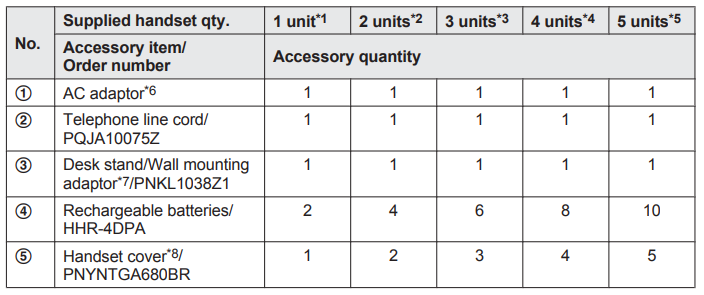

- KX-TG7841/KX-TG7871
- KX-TG7842/KX-TG7872
- KX-TG7843/KX-TG7873
- KX-TG7844/KX-TG7874
- KX-TG7845/KX-TG7875/KX-TG365SK/KX-TG385SK
-
- PNLV226Z: KX-TG7841/KX-TG7842/KX-TG7843/KX-TG7844/KX-TG7845/KX-TG365SK
- PNLV234Z: KX-TG7871/KX-TG7872/KX-TG7873/KX-TG7874/KX-TG7875/KX-TG385SK
- The desk stand/wall mounting adaptor comes attached to the base unit.
- The handset cover comes attached to the handset.

Additional/replacement accessories
Please contact your nearest Panasonic dealer for sales information
- Replacement batteries may have a different capacity from that of the supplied batteries.
- By installing this unit, you can extend the range of your phone system to include areas where reception was previously not available. This product can be purchased online. Please visit our Web site: http://www.panasonic.com/RangeExtender
- By registering the key detector (4 max.) to a Panasonic Digital Cordless Phone and attaching it to an easy-to-lose item in advance, you can locate and find the mislaid item to which the key detector is attached. Please visit our Web site: http://panasonic.net/pcc/products/telephone/p/tga20/
Expanding your phone system
Bluetooth® devices
You can expand your phone system by pairing the following units to a single base unit.
For your safety
To prevent severe injury and loss of life/ property, read this section carefully before using the product to ensure proper and safe operation of your product.
WARNING
Power connection
- Use only the power source marked on the product.
- Do not overload power outlets and extension cords. This can result in the risk of fire or electric shock.
- Completely insert the AC adaptor/power plug into the power outlet. Failure to do so may cause electric shock and/or excessive heat resulting in a fire.
- Regularly remove any dust, etc. from the AC adaptor/power plug by pulling it from the power outlet, and then wiping it with a dry cloth. Accumulated dust may cause an insulation defect from moisture, etc. resulting in a fire.
- Unplug the product from power outlets if it emits smoke, an abnormal smell, or makes an unusual noise. These conditions can cause fire or electric shock. Confirm that the smoke has stopped emitting and contact the Panasonic Call Center at 1-800-211-PANA (1-800-211-7262).
- Unplug from power outlets and never touch the inside of the product if its casing has been broken open.
- Never touch the plug with wet hands. The danger of electric shock exists.
Installation
- To prevent the risk of fire or electrical shock, do not expose the product to rain or any type of moisture.
- Do not place or use this product near automatically controlled devices such as automatic doors and fire alarms. Radio waves emitted from this product may cause such devices to malfunction resulting in an accident.
- Do not allow the AC adaptor or telephone line cord to be excessively pulled, bent, or placed under heavy objects.
Operating safeguards
- Unplug the product from the power outlets before cleaning. Do not use liquid or aerosol cleaners.
- Do not disassemble the product.
- Do not spill liquids (detergents, cleansers, etc.) onto the telephone line cord plug, or allow it to become wet at all. This may cause a fire. If the telephone line cord plug becomes wet, immediately pull it from the telephone wall jack, and do not use it.
Medical
- Consult the manufacturer of any personal medical devices, such as pacemakers or hearing aids, to determine if they are adequately shielded from external RF (radio frequency) energy. (The product operates in the frequency range of 1.92 GHz to 1.93 GHz, and the RF transmission power is 115 mW (max.).)
- Do not use the product in healthcare facilities if any regulations posted in the area instruct you not to do so. Hospitals or healthcare facilities may be using equipment that could be sensitive to external RF energy.
CAUTION
Installation and location
- Never install telephone wiring during an electrical storm.
- Never install telephone line jacks in wet locations unless the jack is specifically designed for wet locations.
- Never touch uninsulated telephone wires or terminals unless the telephone line has been disconnected at the network interface.
- Use caution when installing or modifying telephone lines.
- The AC adaptor is used as the main disconnect device. Ensure that the AC outlet is installed near the product and is easily accessible.
- This product is unable to make calls when: has failed.
- – the handset batteries need recharging or
- – there is a power failure.
Battery
- We recommend using the batteries noted on page USE ONLY rechargeable Ni-MH batteries AAA (R03) size.
- Do not mix old and new batteries.
- Do not open or mutilate the batteries. Released electrolyte from the batteries is corrosive and may cause burns or injury to the eyes or skin. The electrolyte is toxic and may be harmful if swallowed.
- Exercise care when handling the batteries. Do not allow conductive materials such as rings, bracelets, or keys to touch the batteries, otherwise, a short circuit may cause the batteries and/or the conductive material to overheat and cause burns.
- Charge the batteries provided with or identified for use with this product only, by the instructions and limitations specified in this manual.
- Only use a compatible base unit (or charger) to charge the batteries. Do not tamper with the base unit (or charger). Failure to follow these instructions may cause the batteries to swell or explode.
Attention:
A nickel metal hydride battery that is recyclable powers the product you have purchased. Please call 1-800-8-BATTERY (1-800-822-8837) for information on how to recycle this battery.
Important safety instructions
When using your product, basic safety precautions should always be followed to reduce the risk of fire, electric shock, and injury to persons, including the following:
- Do not use this product near water for example, near a bathtub, washbowl, kitchen sink, or laundry tub, in a wet basement, or near a swimming pool.
- Avoid using a telephone (other than a cordless type) during an electrical storm. There may be a remote risk of electric shock from lightning.
- Do not use the telephone to report a gas leak in the vicinity of the leak.
- Use only the power cord and batteries indicated in this manual. Do not dispose of batteries in a fire. They may explode. Check with local codes for possible special disposal instructions.
For best performance
Base unit location/avoiding noise
The base unit and other compatible Panasonic units use radio waves to communicate with each other.
- For maximum coverage and noise-free communications, place your base unit:
- at a convenient, high, and central location with no obstructions between the handset and base unit in an indoor environment.
- away from electronic appliances such as TVs, radios, personal computers, wireless devices, or other phones.
- facing away from radio frequency transmitters, such as external antennas of mobile phone cell stations. (Avoid putting the base unit on a bay window or near a window.)
- Coverage and voice quality depend on the local environmental conditions.
Important Information
- If the reception for a base unit location is not satisfactory, move the base unit to another location for better reception.
Environment
- Keep the product away from electrical noise-generating devices, such as fluorescent lamps and motors.
- The product should be kept free from excessive smoke, dust, high temperature, and vibration.
- The product should not be exposed to direct sunlight.
- Do not place heavy objects on top of the product.
- When you leave the product unused for a long period, unplug the product from the power outlet.
- The product should be kept away from heat sources such as heaters, kitchen stoves, etc. It should not be placed in rooms where the temperature is less than 0 °C (32 °F) or greater than 40 °C (104 °F). Damp basements should also be avoided.
- The maximum calling distance may be shortened when the product is used in the following places: Near obstacles such as hills, tunnels, underground, near metal objects such as wire fences, etc.
- Operating the product near electrical appliances may cause interference. Move away from the electrical appliances.
Routine care
- Wipe the outer surface of the product with a soft moist cloth.
- Do not use benzine, thinner, or any abrasive powder.
Other information
CAUTION: Risk of explosion if the battery is replaced by an incorrect type. Dispose of used batteries according to the instructions.
Notice for product disposal, transfer, or return
- This product can store your private/ confidential information. To protect your privacy/confidentiality, we recommend that you erase information such as phonebook or caller list entries from your memory before you dispose of, transfer, or return the product.
Specifications
- Standard:
- DECT 6.0 (Digital Enhanced
- Cordless Telecommunications 6.0)
- Bluetooth wireless technology 2.0 R
- Frequency range:
- 1.92 GHz to 1.93 GHz (DECT)
- 2.402 GHz to 2.48 GHz (Bluetooth)
- RF transmission power:
- 115 mW (max.) R
- Power source:
- 120 V AC, 60 Hz
- Power consumption:
- Base unit:*1
- Standby: Approx. 1.2 W
- Maximum: Approx. 4.5 W
- Base unit:*2
- Standby: Approx. 1.2 W Maximum: Approx. 8.5 W
- Charger:
- Standby: Approx. 0.1 W
- Maximum: Approx. 1.8 W
- Base unit:*1
- USB Charger:*2
- Output voltage: DC 5 V
- Output current: 500 mA R
- Operating conditions:
- 0 °C – 40 °C (32 °F – 104 °F), 20 % – 80 % relative air humidity (dry)
Note:
- Design and specifications are subject to change without notice.
- The illustrations in these instructions may vary slightly from the actual product.
Getting Started
Setting up Connections
- If you do not connect the telephone line cord and use only cellular lines, set the cellular line only mode to use this unit more conveniently
- Base unit (KX-TG7841 series: )
- Use only the supplied Panasonic AC adaptor PNLV226.
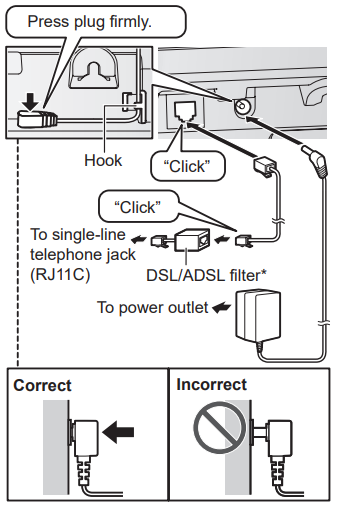
- Use only the supplied Panasonic AC adaptor PNLV226.
- Base unit (KX-TG7871 series:)
- Use only the supplied Panasonic AC adaptor PNLV234.
- The hook of the base unit is not designed to hold the AC adaptor cord for the desk stand or wall mounting use

- Charger
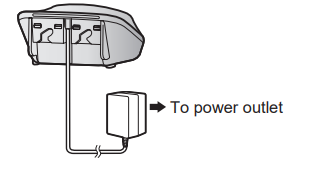
Battery installation
- USE ONLY Ni-MH batteries AAA (R03) size.
- Do NOT use Alkaline/Manganese/Ni-Cd batteries.
- Confirm correct polarities (, ).

Battery charging
- Charge for about 7 hours. When the batteries are fully charged, “Fully charged” is displayed.

Note when setting up
Note for connections
- The AC adaptor must remain connected at all times. (It is normal for the adaptor to feel warm during use.)
- The AC adaptor should be connected to a vertically oriented or floor-mounted AC outlet. Do not connect the AC adaptor to a ceiling-mounted AC outlet, as the weight of the adaptor may cause it to become disconnected.
Note for battery installation
- Use the supplied rechargeable batteries. For replacement, we recommend using the Panasonic rechargeable batteries noted on
- Wipe the battery ends (, ) with a dry cloth.
- Avoid touching the battery ends (, ) or the unit contacts.
Note for battery charging
- It is normal for the handset to feel warm during charging.
- Clean the charge contacts of the handset, base unit, and charger with a soft and dry cloth once a month. Before cleaning the unit, disconnect from power outlets and any telephone line cords. Clean more often if the unit is exposed to grease, dust, or high humidity.
Battery level

Controls
Handset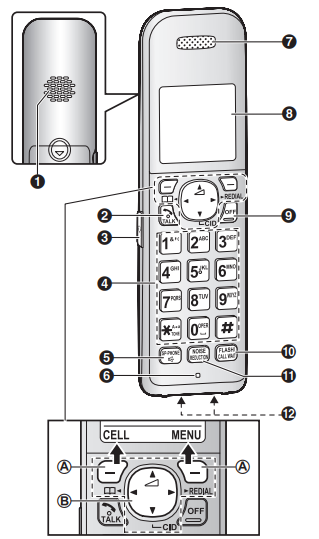
- Speaker
- M N (TALK)
- Headset jack
- Dial keypad (*: TONE)
- MZN (SP-PHONE: Speakerphone)
- Microphone
- Receiver
- Display
- OFF
- FLASH CALL WAIT
- NOISE REDUCTION
- Charge contacts
Base unit
- USB jack (KX-TG7871 series: page 3)
- Charge contacts
- Speaker
- Display
- HOLD
- REDIAL PAUSE
- FLASH CALL WAIT
- (SP-PHONE: Speakerphone)
- SP-PHONE indicator
- ERASE
- ANSWER ON/OFF ANSWER ON/OFF indicator
- LOCATOR INTERCOM
- (STOP) (EXIT)
- (PLAY)
- Message indicator
- CELL 1
- CELL 1 indicator
- CELL 2
- CELL 2 indicator
- Desk stand/Wall mounting adaptor
- The adaptor is a removable attachment for desk stand or wall mounting use
- Microphone
- Dial keypad (*: TONE)
Charging the cellular phone by USB
By connecting a USB cable (not supplied) to the cellular phone and the base unit, you can charge a cellular phone. However, the cellular phone cannot exchange data with the base unit through a USB cable.
Belt clip 
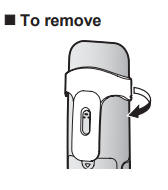
Display/Indicators
Handset display items



- Corresponding cellular line(s) is(are) indicated next to the item.
- During a cellular call, the item is not displayed even though the feature is activated.
- Corresponding lines (1, 2: cellular line, L: landline) are indicated next to the item. If all lines are turned off, no line is indicated.
Base unit display items
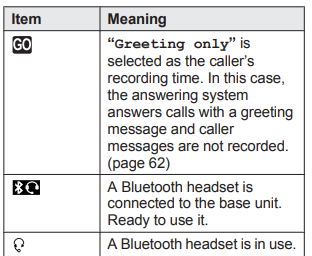
CELL 1/CELL 2 indicators on the base unit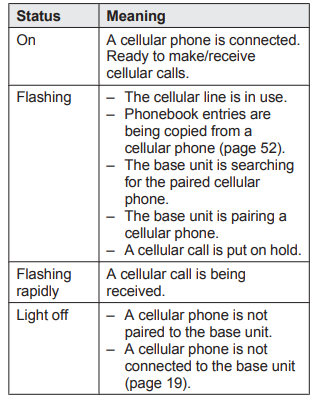
Link to cell feature
To use this feature, you must first pair and connect your cellular phones to the base unit Your cellular phones must have Bluetooth wireless technology that is compatible with this product. This feature allows you to:
- make or answer cellular calls using your home phone (handset or base unit) with better reception.
- maximize the benefits of cellular services(such as free night and weekend calls, or cellular to cellular call plans) by utilizing unused peak minutes with your home phone.
- conserve the battery power of your cellular phone while the unit is on a cellular call. (We recommend charging your cellular phone during the cellular call as your cellular phone battery is being consumed.)
Important:
- You may pair a maximum of 2 cellular phones and 1 headset. However, the base unit allows only one Bluetooth to be active at a time.
- Locate your cellular phone near the base unit. If the cellular phone is too close to the base unit during a cellular call, you may hear noise. For best performance, we recommend placing the cellular phone between 0.6 m to 3 m (2 feet to 10 feet) away from the base unit.
Ring as cell mode
Once this feature is turned on, the handset and base unit ring using the same ringer tone as your cellular phone. The following settings are available:
- “Off”: Turn this feature off to use the ringer tones of the handset and base unit. Caller information is announced depending on the Talking Caller ID setting (page 40). – “On (with Talking CID)” (default): The handset and base unit use your cellular phone’s ringer tone. Caller information is announced even if the Talking Caller ID is turned off.
- “On (without Talking CID)”: The handset and base unit use your cellular phone’s ringer tone. Caller information is not announced even if the Talking Caller ID is turned on.
Important:
- To use this feature, your cellular phone must support Bluetooth in-band ringtone. Refer to your cellular phone’s operating instructions.
Transferring a cellular call between the handset and a cellular phone
- Press MMENUN during a cellular call.
- MbN: “Transfer to cell” an MSELECTN
- The cellular call is transferred to the cellular phone.
Note:
- Depending on your cellular phone type, you may need to set the cellular phone to be ready to talk before transferring. For example, if your cellular phone has a top cover, open it beforehand.
Transferring a cellular call from a cellular phone to the handset
During a conversation using a cellular phone, the call cannot be transferred to the handset by the cellular phone. Perform the following with the handset.
- During a conversation using a cellular phone, press CELL.
- The call is transferred to the handset when:
- only 1 cellular phone is paired.
- a specific line is set to make cellular calls
- MbN: Select the desired cellular phone. a SELECT
- The call is transferred to the handset.
- The call is transferred to the handset when:
Using the other line during a conversation
You can handle a cellular call and a landline call at the same time. When another call is being received during a conversation, the interrupt tone sounds (page 39), and the 2nd caller’s information is displayed if you subscribe to the Caller ID (page 48). You can answer the 2nd call while holding the 1st call.
Making/answering a cellular call during a conversation on the landline
- Press MMENUN during a landline call.
- MbN: “Hold” a MSELECTN
- To make a 2nd call:
- Dial the phone number. a CELL: Select the desired cellular phone. a
- SELECT The unit starts dialing when:
- only 1 cellular phone is paired.
- a specific line is set to make cellular calls (page 20).
- To answer a 2nd call:
- CELL To hold the 2nd call: MENU: “Hold” a SELECT
- To hang up the 2nd call and return to the 1st call (landline call), press OFF, then press
Power back-up operation for landline
When a power failure occurs, the charged handset temporarily supplies power to the base unit (power backup mode). This allows you to make and receive landline calls using a handset during a power failure. The base unit will not perform any other functions. However, some functions such as Caller ID and shared phonebook are available only when using a handset other than the handset supplying power to the base unit. You can program “Power failure” and the default setting is “Auto”
Important:
- If a handset is not placed on the base unit when a power failure occurs, “Base no power Press OFF” is displayed. After pressing MOFFN on the handset, place it on the base unit to start power backup mode.
- Power back-up mode will not work if the battery level of the power-supplying handset is or.
- Do not lift the power-supplying handset from the base unit during power backup mode.
- Do not touch the handset’s charge contacts during power backup mode.
- If the battery level is low, the unit will not work sufficiently during power backup mode. In addition, in case handset battery power runs out, we recommend connecting a corded-type telephone (without an AC adaptor) to the same telephone line or the same telephone line jack using a Panasonic T-adaptor (page 4).
Panasonic Ni-MH battery performance (supplied batteries) during power backup mode
When the batteries are fully charged, the operating time of the handset in power backup mode varies depending on usage.
- Continuous use of the handset in power backup mode: 1.5 hours max.
- Continuous use of the handset other than a handset in power back-up mode: 2 hours max.
- Not in use in power backup mode: 2 hours.
Note:
- Actual battery performance depends on usage and the ambient environment.
Wall mounting
The base unit can be mounted on a wall by changing the wall mounting adaptor’s position.
Note:
- Make sure that the wall and the fixing method are strong enough to support the weight of the unit.
- The model shown is the KX-TG7841 series.
Base unit
- To remove the wall mounting adaptor, push down the release levers (A). Remove the adaptor (B)
 .
. - Turn the adaptor so that the words “UP WALL” are facing up. B Tuck the telephone line cord inside the wall mounting adaptor. C Connect the AC adaptor cord and telephone line cord

- Insert the lower tabs of the adaptor into the unit’s bottom slots (A), then insert by pushing down the levers of the adaptor into the upper slots (B).
- The words “UP WALL” should be facing up

- The words “UP WALL” should be facing up
- Mount the unit on a wall then slide down to secure it in place.
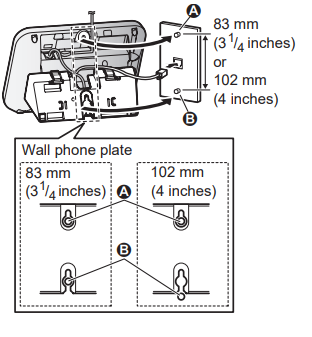
Charger
Drive the screws (not supplied) into the wall
Troubleshooting
If you still have difficulties after following the instructions in this section, disconnect the base unit’s AC adaptor, then reconnect the base unit’s AC adaptor. Remove the batteries from the handset, and then insert the batteries into the handset again.
General use
Useful Information
Programmable settings
Battery recharge
Making/answering calls, intercom 

Useful Information
Caller ID/Talking Caller ID


Using Bluetooth devices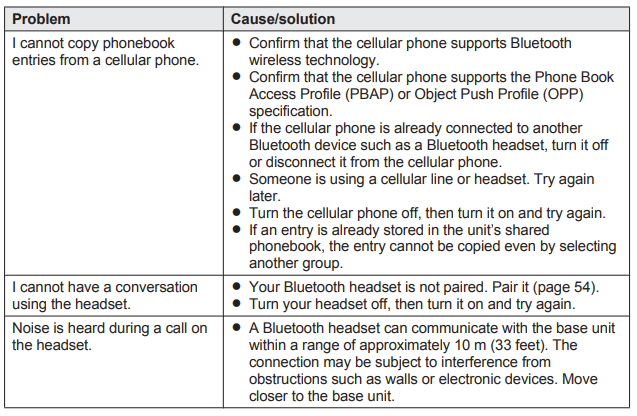
Useful Information
Answering system
Bluetooth PIN
Liquid damage
Caution:
- To avoid permanent damage, do not use a microwave oven to speed up the drying process.
FCC and other information
This equipment complies with Part 68 of the FCC rules and the requirements adopted by the ACTA. On the bottom of this equipment is a label that contains, among other information, a product identifier in the format US: ACJ———-. If requested, this number must be provided to the telephone company.
-
- Registration No………….(found on the bottom of the unit)
- Ringer Equivalence No. (REN)…….0.1B
- A plug and jack used to connect this equipment to the premises wiring and telephone network must comply with the applicable FCC Part 68 rules and requirements adopted by the ACTA. A compliant telephone cord and modular plug are provided with the product. It is designed to be connected to a compatible modular jack that is also compliant.
- The REN is used to determine the number of devices that may be connected to a telephone line. Excessive RENs on a telephone line may result in the devices not ringing in response to an incoming call. In most but not all areas, the sum of RENs should not exceed five (5.0). To be certain of the number of devices that may be connected to a line, as determined by the total RENs, contact the local telephone company. For products approved after July 23, 2001, the REN for the product is part of the product identifier that has the format US: AAAEQ##TXXXX. The digits represented by ## are the REN without a decimal point (e.g., 03 is a REN of 0.3).
- If this equipment causes harm to the telephone network, the telephone company will notify you in advance that temporary discontinuance of service may be required. But if advance notice isn’t practical, the telephone company will notify the customer as soon as possible. Also, you will be advised of your right to file a complaint with the FCC if you believe it is necessary.
- The telephone company may make changes in its facilities, equipment, operations, or procedures that could affect the operation of the equipment. If this happens the telephone company will provide advance notice for you to make necessary modifications to maintain uninterrupted service.
- If trouble is experienced with this equipment, for repair or warranty information, please contact a Factory Service Center or other Authorized Servicer. If the equipment is causing harm to the telephone network, the telephone company may request that you disconnect the equipment until the problem is resolved.
- Connection to party line service is subject to state tariffs. Contact the state public utility commission, public service commission, or corporation commission for information.
- If your home has specially wired alarm equipment connected to the telephone line, ensure the installation of this equipment does not disable your alarm equipment. If you have questions about what will disable alarm equipment, consult your telephone company or a qualified installer.
- This equipment is hearing aid compatible as defined by the FCC in 47 CFR Section 68.316. When you hold the phone to your ear, noise might be heard in your Hearing Aid. Some Hearing Aids are not adequately shielded from external RF (radio frequency) energy. If noise occurs, use an optional headset accessory or the speakerphone option (if applicable) when using this phone. Consult with your audiologist or Hearing Aid manufacturer about the availability of Hearing Aids which provide adequate shielding to RF energy commonly emitted by digital devices.
WHEN PROGRAMMING EMERGENCY
NUMBERS AND(OR) MAKING TEST CALLS TO EMERGENCY NUMBERS:
- Remain on the line and briefly explain to the dispatcher the reason for the call.
- Perform such activities in the off-peak hours, such as early morning or late evening.
This device complies with Part 15 of the FCC Rules. Operation is subject to the following two conditions:
- This device may not cause harmful interference, and
- this device must accept any interference received, including interference that may cause undesired operation. Privacy of communications may not be ensured when using this phone.
CAUTION:
Any changes or modifications not expressly approved by the party responsible for compliance could void the user’s authority to operate this device.
NOTE:
This equipment has been tested and found to comply with the limits for a Class B digital device, under Part 15 of the FCC Rules. These limits are designed to provide reasonable protection against harmful interference in a residential installation. This equipment generates, uses, and can radiate radio frequency energy and, if not installed and used by the instructions, may cause harmful interference to radio communications. However, there is no guarantee that interference will not occur in a particular installation. If this equipment does cause harmful interference to radio or television reception, which can be determined by turning the equipment off and on, the user is encouraged to try to correct the interference by one or more of the following measures:
- Reorient or relocate the receiving antenna.
- Increase the separation between the equipment and the receiver.
- Connect the equipment to an outlet on a circuit different from that to which the receiver is connected.
- Consult the dealer or an experienced radio/TV technician for help.
Some cordless telephones operate at frequencies that may cause interference to nearby TVs and VCRs. To minimize or prevent such interference, the base of the cordless telephone should not be placed near or on top of a TV or VCR. If interference is experienced, move the cordless telephone further away from the TV or VCR. This will often reduce or eliminate interference.
FCC RF Exposure Warning:
- This product complies with FCC radiation exposure limits set forth for an uncontrolled environment.
- To comply with FCC RF exposure requirements, the base unit must be installed and operated 20 cm (8 inches) or more between the product and all person’s body (excluding extremities of hands, wrist, and feet).
- This product may not be collocated or operated in conjunction with any other antenna or transmitter.
- The handset may be carried and operated with only the specific provided belt clip. Other non-tested belt clips or similar body-worn accessories may not comply and must be avoided.
Notice:
- FCC ID can be found inside the battery compartment or on the bottom of the units.
Compliance with TIA-1083 standard: Telephone handsets identified with this logo have reduced noise and interference when used with T-Coil-equipped hearing aids and cochlear implants.
FAQs About Panasonic KX-TG7875S Link2Cell Bluetooth Cordless Phone
What is the mechanism of Panasonic Link2Cell?
For crystal-clear mobile phone use even in cell-dead zones, Link2Cell pairs the home phone with up to 2 smartphones using Bluetooth. Smart Call Block features make blocking and avoiding obnoxious callers simpler than ever.
How far can Panasonic cordless phones go?
Your home or apartment, as well as your yard, should be accessible to you and your phone without losing the call. The advertised range of Panasonic’s phones is 1,300 feet, and VTech’s premium phones, which include AT&T-branded devices, are said to have ranges of up to 2,300 feet.
Are new Panasonic phone batteries required?
A cordless phone’s battery typically lasts between one and two years. In rare circumstances, it might not be possible to recharge within a year. This is probably due to the battery having previously been charged and being allowed to drain to an unsafe voltage.
Is it possible to install one more cordless phone?
Do not fret. One of the many advantages of cordless phones is how simple it is to expand your system with extra handsets. Therefore, whether you want to keep one close by at home or need a few more phones for the workplace, we have you covered.
Can you connect a mobile phone to a landline?
Your cell phone and your current landline phone are connected using CELL2JACK. Now you may use your mobile phone calling plan and make and receive calls on any extension of your home landline phone without worrying about exposure to dangerous cellular signal radiation.
Link to Cell: What does it do?
Up to two smartphones can be connected with the touch of a button so that mobile calls are made and received through your Link2Cell telephones.
Panasonic wireless phones are they digital?
With Call Block Key, Nuisance Call Block, and Enhanced Receiver Volume, Panasonic Digital Cordless Phone. simple and refined with improved features. A digital cordless phone featuring call blocking functionality, an improved receiver, and more.
How do Panasonic phones perform?
These Panasonic cordless phone systems are all practically faultless. Excellent voice quality, a virtually infinite number of features, and a wide selection. There wasn’t much, but a few significant variances did show up. The keys on the latest model (4745B) are MUCH BIGGER.
Panasonic batteries: do they leak?
Panasonic Alkaline batteries can be kept for up to 10 years*. Titanium is added to special high-quality chemistries to avoid deterioration, and Anti-Leak Seal stops leaks to provide stability over a long period of time.
Are Panasonic batteries required for Panasonic phones?
Batteries called Nickel-Metal Hydride (NiMH) are used in your Panasonic cordless phone. They fall under the rechargable battery category. You will want new AAA batteries if the battery in your phone no longer charges. These batteries have to be Nickel-Metal Hydride.
For more manuals by Panasonic, visit Manualsdock




